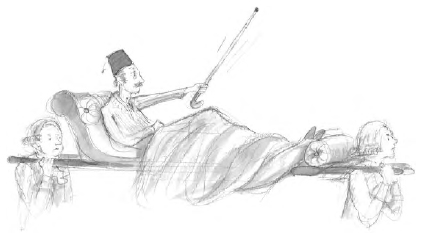
IN THE PAST, it was not unusual for a king or queen to rule more than one country. Four was usually the maximum. It is difficult to rule more than four countries, and perhaps not altogether wise. But once there was a Queen who ruled seven. Her father, the King, died when she was only nine, and left four countries of his own. When she was twelve she inherited two more lands from a great-aunt whom she had never even met. And finally one of her generals thought it would be nice to give a special gift for her sixteenth birthday—so he conquered an extra country just for the occasion.
The Queen, of course, had been taught from her earliest years that she must love each of her countries as if she had no other. But the only one she had seen was the one in which she had been born. In those days, there was no really quick way of travelling around. There were no aeroplanes, cars or trains. The fastest way to get from place to place was in a carriage drawn by horses. The only way to cross the sea was in a sailing ship blown by the wind. People rode camels in the deserts and took elephants into the jungles, climbed mountains on mules and crossed ice in sleds pulled by husky dogs. And if they had no horses or camels or elephants or mules or dogs—they walked.
The Queen’s seven lands had everything. There was snow in the north and desert in the south, mountains in the middle and vast blue oceans between one country and the next. The Queen could not possibly have crossed all these obstacles. It would have taken far too long, and she would have had no time left for anything else. A Queen who has to look after her Court is much too busy for that.
But this didn’t mean that the young Queen knew nothing about the lands that belonged to her. On the contrary, she knew a great deal. It was her duty to know, and it was also a pleasure.
There were always travellers and explorers who had come back from one place or another. The most fascinating explorer of all was Mr Sutton Pufrock, who had been everywhere when he was younger. He was old now, of course, and rarely got out of bed, yet he was never without a faraway story to tell, just as if he were a traveller still. The Queen often asked for him to be brought to the palace so she could hear him speak, and her footmen would fetch him on a stretcher. Sutton Pufrock always had a stubble on his chin, for he rarely shaved, and his forehead was broad and high. He waved his walking-stick wildly when he got to the exciting parts of his stories, and those who strayed too close were sometimes hit on the head.

Yet travellers often exaggerate, as the Queen knew, and Sutton Pufrock, with his whirling walking-stick, probably exaggerated more than anybody else. No, the only things you could really trust were those that you saw with your own eyes. Every year, the people in the Queen’s countries sent special presents for her birthday. The Queen could see these for herself. As soon as she had unpacked the presents for one birthday, she began to look forward to the next. For a month in advance she was too excited to concentrate on anything else.
There was hardly a thing that could be moved, carried or dragged that had not been sent to the Queen as a present. Since no two of her countries were alike, no two presents were the same. And it wasn’t only furniture, ornaments, chess-sets and woven carpets that the Queen received. Crates arrived containing unusual animals that no one at Court had ever seen before, with strange names written on labels hanging around their necks.
The first to arrive was a giraffe. He came as a present for the Queen’s coronation, and being only nine, she was barely able to reach his knee. The Queen was too young to choose where to put him, so the Prime Minister and the Stablekeeper had to decide for her. It was no simple matter. There was nowhere with a roof that was high enough! They kept him in his crate for a month, hoping that the giraffe’s neck had somehow been stretched by his difficult sea journey, and that it might shrink with time. Every day the Stablekeeper took him out for a walk through the town on a leather leash. But it wasn’t long before they realised that the giraffe, who was obviously quite young, was actually growing. Eventually they let him loose in the park that surrounded the palace. Soon he was a familiar sight, cantering with his loose, loping run or standing with his head lost in the trees. People walking outside the palace wall sometimes looked up to find his soft, curious eyes gazing down at them.
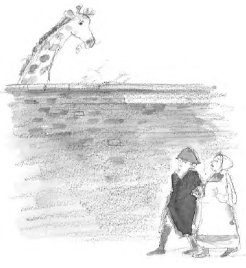
After the giraffe, a rhinoceros turned up. There was nowhere for him either, so they put him in the park as well. Visiting ambassadors got a terrible fright when they were out for a stroll and the rhinoceros suddenly appeared in front of them. His horn was two feet long! But the rhinoceros was too lazy to attack anybody. His skin was thick and his legs were sturdy, and since he would have won a fight with almost any other creature, he never bothered to start one.
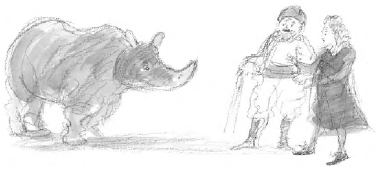
So the palace park became home for the animals that were sent to the Queen. After a few years it was teeming with them. There was a pair of water buffalo who spent the whole day churning up and down through the mud beside the lake. Two lions and a black jaguar stalked in a section that had been set aside especially for them. Zebras, antelope and a yellow llama roamed the open ground, looking for the most succulent grasses. There were seven different sorts of monkeys, including two kinds of baboons with faces painted like clowns. Each tribe had its own trees and was always attacking the territory of the others, just like people. There was a moose, which some people called an elk, who completely ignored the monkey wars that took place above his antlers. A very solemn emperor penguin reluctantly shared his pool with a playful seal. There were bats who lived in a cave on the edge of the park, possums and a sleek, shiny mink, who all came out at night. And there were birds …
The birds lived in a gigantic cage that the palace blacksmith had constructed. It was so big that the whole palace could have fitted into it! The Stablekeeper said there were two hundred and eighty different kinds of birds inside, but the truth was that he had lost count and nobody knew for sure. There were parrots, puffins, woodpeckers, nutcrackers, fruitflickers, cockatoos, toucans, lyrebirds, songbirds, mutton-birds, firebirds, lovebirds, rumbirds and at least three hornbills, gigantic black birds from the jungles of the south, with bright faces and a haunting cry that came out of the hollow horn around their beaks. There were nests in every tree, eggs in every nest, chicks turning into fledglings and fledglings turning into adults. The cage was at the very centre of the park and it flashed with colour and exploded with noise from dawn to dusk.
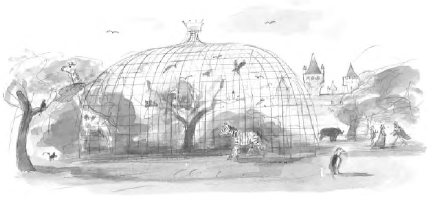
Of course, the people sent plants as well. They sent seeds and nuts that the Queen’s gardeners could grow. They sent bushes and cactuses, they sent whole trees in enormous pots. No matter what time of year it was, somewhere in the palace park you were sure to find a shrub covered in gorgeous flowers or a tree with delicious fruit hanging from its branches. And when a plant would not grow in the palace park, because the weather was too hot or too cold for it, the people sent its fruits for the Queen to taste.
They picked the fruits when they were hard and green, and packed them carefully in boxes lined with cotton wool. By the time they had crossed the sea and arrived at the Queen’s palace they were just ripe and ready to eat. This was the Queen’s favourite kind of present. There was nothing she loved more than biting into a rich, sweet, delicious fruit that had come from over the seas. The Queen had tasted every fruit that grew in her seven countries, every single fruit except the melidrop.
The melidrop was not a particularly large fruit—not much bigger than an egg, or not much smaller than a pomegranate. Its skin went yellow or red as it ripened. Some people said that its flesh tasted like spicy currants dipped in honey, while some said it was like spicy honey mixed with currants. Others described it as cinnamon custard with walnut syrup. Others who had eaten it refused to say what it was like, claiming that there was nothing else on earth so sweet, smooth and delicious with which it could be compared.
Melidrops grew far to the south, in the hottest of the Queen’s countries. Year after year, she heard about these mouth-watering melidrops and waited to taste them.
The people sent melidrop seeds, but they failed to shoot. They sent melidrop trees, but their leaves curled up and died. Then the people tried sending melidrop fruit, but no matter how early they picked them, the fruit always spoiled in the box. The Queen would open the packing case to find a disgusting, smelly pile of darkened melidrop skins.
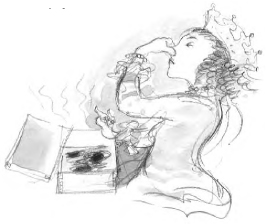
Sutton Pufrock didn’t know why people bothered sending the packing cases, or why the Queen even bothered opening them. On her most recent birthday, while the Queen was still staring at a revolting pile of rotten melidrops that had just arrived, he said: ‘It’s only to be expected. You have to eat a melidrop the day it’s picked. Everyone knows that. That’s what melidrops are like. It’s a simple fact: after a day, they rot.’
The Queen glared at Sutton Pufrock. The courtiers stared at him as well. They had all come to the palace and were gathered in the Throne-room to watch the Queen open her presents.
‘It is the most delicious fruit,’ Sutton Pufrock continued nostalgically. ‘Nothing can compare to it. I remember, when I was younger and far away on my travels, I would sometimes spend a day beneath a melidrop tree, plucking one fruit after another to my heart’s content. I would advise anyone who has the opportunity to do the same.’
The Queen shrieked in frustration and slammed the lid of the box. She ordered her footmen to carry Sutton Pufrock away immediately.
It was too much. It was just too much! For years people had been sending her melidrop seeds, melidrop trees and melidrop fruit, and she had still not succeeded in tasting a single one. It was just too humiliating for a Queen to bear.
‘That’s the end of the matter,’ she shouted icily, as Sutton Pufrock’s stretcher disappeared out of the Throne-room on the shoulders of the footmen.
The Queen gazed around at her courtiers to see if anyone dared to disagree. They looked back at her blankly. A courtier did not disagree with the Queen, and if he did, he certainly did not show it. Besides, quite a few of them didn’t even like Sutton Pufrock and his never-ending travel stories, and they were not sorry to see him go. They waited for the Queen to open the rest of her presents.
But the Queen did not feel like opening any of the other boxes that stood in the Throne-room. She didn’t feel like going out into the park to watch her animal-keepers unlock the cages that had arrived, even though one of them was said to contain a strange new animal called a walrus.
‘That is the end of the matter,’ the Queen repeated, just in case anyone had not heard her the first time. ‘No one at my Court will mention the word melidrop again. Not to me. Not to anyone else. Not to anybody. Ever. The melidrop refuses to come to the Queen. Therefore, at the Queen’s Court, the melidrop does not exist.’
The Queen glared at everybody a moment longer. Then she turned on her heel and walked out, leaving the footmen to gather up her birthday boxes and run after her.